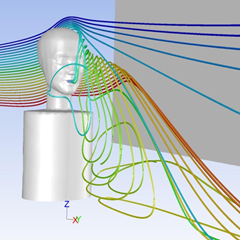Breadcrumb
Computational Fluid Dynamics - Using Engineering Tools to Solve Public Health Questions
Computational fluid dynamics (CFD) to complete engineering designs has been used for years. These methods can also be useful to understanding how contaminants are transported throughout the environment, making this a powerful tool to incorporate into public health. A video demonstrating this process is available at https://youtu.be/f4m-kBMRZkQ.
In this lab, we have used these same tools to investigate how particles move through slow moving air and enter into the human respiratory system or into samplers.

A six-year project examining how efficiently particles enter into the mouth and nose of a breathing worker has resulted in an improved understanding of where particles travel prior to entering the respiratory system. This work was funded by NIOSH/CDC (R01 OH009290). Articles include:
- Anthony TR, Flynn MR, Eisner A (2005) Evaluation of facial features on particle inhalation. Annals of Occupational Hygiene, 49(2): 179-193. [PMID 15734830]
- Anthony TR, Flynn MR (2006) CFD model for a 3-D inhaling mannequin: Verification and validation of fluid flow. Annals of Occupational Hygiene, 50(2): 149-156. [PMID 16157607]
- Anthony TR, Flynn MR (2006) Computational fluid dynamics investigation of particle inhalability. Journal of Aerosol Science, 37(6): 750-765. [PMID 20457783]
- Anthony TR (2010) Contribution of facial feature dimensions and velocity parameters on particle inhalability. Annals of Occupational Hygiene, 54(7): 710-725. [PMC4780249]
- Anderson KR and Anthony TR. (2013) Uncertainty in aspiration efficiency estimates due to torso simplifications in computational fluid dynamics (CFD) simulations. Annals of Occupational Hygiene,57(2): 184-199. [PMC3634334]
- Anthony TR and Anderson KR (2013) Computational fluid dynamics investigation of human aspiration in low velocity air: Orientation effects on mouth breathing simulations. Annals of Occupational Hygiene, 57(6): 740-757. [PMC3916737]
- Anderson K, Anthony TR. (2014) Computational fluid dynamics investigation of human aspiration in low velocity air: Orientation effects on nose breathing simulations. Annals of Occupational Hygiene, 58(5): 625-645. [PMC4305117]
- Anderson KR, Anthony TR. (2014) Influence of secondary aspiration on human aspiration efficiency. Journal of Aerosol Science,75: 65-80. [PMC4711272]
- Anthony TR, Anderson KR. (2015) An empirical model of human aspiration in low velocity air using CFD investigations. Journal of Occupational and Environmental Hygiene, 12(4):245-255. [PMC47353566] (NOTE: Best Paper of 2015 JOEH)
In addition to examinations of human aspiration, CFD has been used to develop size-selective sampler prototypes. Initial investigations of a new sampler inlet for the purposes of designing a disposable inhalable sampler (collecting the large particles with efficiency matching the human head, above) included evaluation of a meshed entry to prevent particles larger than 100 um from entering the sampler. However, we identified that this, and indeed any available sampler with a meshed entry, could be problematic for liquid aerosols, as larger inhalable particles must bounce many times prior to being aspirated into the sampler. Articles on this modeling and subsequent bench testing of these initial samplers are below. Further work is underway to improve this high-flow, low cost sampler. This work is funded by NIOSH / CDC (R21 OH009114 and R01 OH010295).
- Anthony TR, Landazuri AC, Van Dyke M, Volckens J (2010) Design and Computational Fluid Dynamics investigation of a personal, high-flow inhalable sampler. Annals of Occupational Hygiene, 54(4): 427-442. [PMC4780251]
- Koehler KA, Anthony TR, Van Dyke M. Volckens J (2011) A rotating, bluff-body disc for reduced variability in wind tunnel aerosol studies. Annals of Occupational Hygiene, 55(1): 86-96. [PMC4780254]
- Koehler KA, Anthony TR, Van Dyke M, Volckens J (2012) Solid versus liquid particle aspiration efficiency of three personal aerosol samplers, Annals of Occupational Hygiene, 56(2): 194-206 [PMC4776657]
- L’Orange C, Anderson KR, Sleeth D, Anthony TR, and Volckens J. (2016) Simple, Low-Cost Sampler for Inhalable Aerosol. Annals of Occupational Hygiene, 60(2): 150-160. [PMC4753567]
- Anthony TR, Sleeth DK, Volckens J (2016). Sampling efficiency of modified 37-mm sampling cassettes using computational fluid dynamics. Journal of Occupational and Environmental Hygiene, 13(2):148-158. [PMC4706812] (NOTE: Paper received David Swift Award by the Aerosols Technology Committee of AIHA in June 2017 as the "best aerosol paper" in the JOEH.)
- Landazuri AC, Anthony TR, Saez E (2016). Three-Dimensional Computational Fluid Dynamics Modeling of Particle Uptake by an Occupational Air Sampler using Manually-Scaled and Adaptive Grids. Journal of Aerosol Sciences, 95:54-66. [PMC4774053]